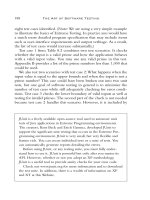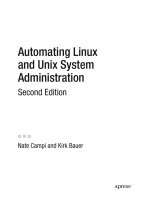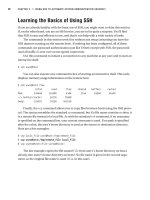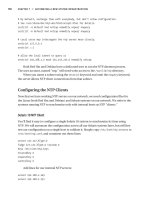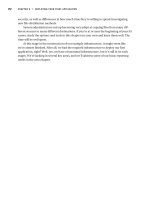Automating Linux and Unix System Administration Second Edition phần 9 potx
Bạn đang xem bản rút gọn của tài liệu. Xem và tải ngay bản đầy đủ của tài liệu tại đây (178.42 KB, 44 trang )
CHAPTER 11 INFRASTRUCTURE ENHANCEMENT
341
_`z+i]opanbehao+LNK@+nalh+nkkp+
ig`en)lge_gop]np+ndah1[.
o_l)nnkkp<ndi]opan6+ge_gop]np+_bajceja).*.*3ge_gop]np+
o_l)nnkkp<ndi]opan6+ge_gop]np+o_nelpoge_gop]np+
o_lnkkp<ndi]opan6+ge_gop]np+ndah1[.+go*_bcge_gop]np+ndah1[.+
orj]``ge_gop]np
After that, we needed to copy out these files to the +ge_gop]np directory on the host
rhmaster using cfengine. Once again in our working copy, we created the directory
LNK@+
ejlqpo+p]ogo+]ll+ge_gop]np, and created a task in the directory called _b*_klu[ge_gop]np[
`en with these contents:
_klu6
ge_gop]np[oanran66
$i]opan%+nalh+nkkp+ge_gop]np
`aop9+ge_gop]np
ik`a9311
n9ejb
ksjan9nkkp
cnkql9nkkp
pula9_da_goqi
oanran9 $behaoanran%
aj_nulp9pnqa
`ena_pkneao6
ge_gop]np[oanran66
+ge_gop]npik`a9311ksjan9nkkpcnkql9nkkpejbkni9b]hoa
We added the LNK@+ejlqpo+p]ogo+]ll+ge_gop]np directory to Subversion with orj]``
once we had the task file inside it. Next, we needed to do the usual steps in order to make
this task get used by our Kickstart server. Here’s a summary of the steps:
1. Create the
ge_gop]np[oanran class in LNK@+ejlqpo+_h]ooao+_b*i]ej[_h]ooao.
2. Create the hostgroup file at
LNK@+ejlqpo+dkopcnkqlo+_b*ge_gop]np[oanran that
imports the
_b*_klu[ge_gop]np[`en task. Add the file to the Subversion repository.
3. Set up the hostgroup import in the hostgroup mapping file
LNK@+ejlqpo+
dkopcnkqlo+_b*dkopcnkql[i]llejco.
4. Commit the changes to your working copy, and update the production working
copy on the cfengine master.
CHAPTER 11 INFRASTRUCTURE ENHANCEMENT
342
Now our important Kickstart files are contained in Subversion and will be restored by
cfengine via a copy if we ever have to rebuild our Kickstart server.
FAI
When we set up FAI, we were careful to modify the default FAI configuration files as little
as possible. We wanted to be able to push new files as much as possible, since we knew
that we would want to distribute those files using cfengine later on.
We collected all the files under the +onr+b]e+_kjbec directory that we modified or
added back in Chapter 6 in our working copy of the repository:
ls`
+dkia+j]pa+i]opanbehao+LNK@+nalh+nkkp+onr+b]e+_kjbec
ho)N
*6
*+**+_h]oo+`eog[_kjbec+behao+dkkgo+l]_g]ca[_kjbec+o_nelpo+
*+_h]oo6
*+**+2,)ikna)dkop)_h]ooao&B=E>=OA*r]n
*+`eog[_kjbec6
*+**+HKCDKOPSA>
*+behao6
*+**+ap_+
*+behao+ap_6
*+**+_bajceja+
*+behao+ap_+_bajceja6
*+**+_b]cajp*_kjb+ql`]pa*_kjb+
*+behao+ap_+_bajceja+_b]cajp*_kjb6
*+**+B=E>=OA&
*+behao+ap_+_bajceja+ql`]pa*_kjb6
*+**+B=E>=OA&
*+dkkgo6
*+**+o]rahkc*H=OP*okqn_a&
CHAPTER 11 INFRASTRUCTURE ENHANCEMENT
343
*+l]_g]ca[_kjbec6
*+**+B=E>=OAHKCDKOPSA>
*+o_nelpo6
*+**+B=E>=OA+
*+o_nelpo+B=E>=OA6
*+**+1,)_bajceja&2,)_na]pa)_b)_kjbec&
We’ll distribute all these as another recursive copy, this time into the +onr+b]e+_kjbec
directory on the FAI server (goldmaster). We have some additional files that we modified
during the setup of our FAI server:
+ap_+b]e+i]ga)b]e)jbonkkp*_kjb
+ap_+`d_l/+`d_l`*_kjb
+ap_+ejap`*_kjb
There is a problem with +ap_+ejap`*_kjb: in the task LNK@+ejlqpo+p]ogo+]ll+nouj_+
_b*aj]^ha[nouj_[`]aikj, we add a line to +ap_+ejap`*_kjb using the a`epbehao action.
This
a`epbehao action must be changed or removed, since it makes no sense to have an
a`epbehao action acting on a file that cfengine is also copying out. Two scenarios could
result, depending on the contents of the
ejap`*_kjb file that cfengine copies into place:
+ap_+ejap`*_kjb file won’t have the entry that the task _b*aj]^ha[
nouj_[`]aikj is looking for, and it will be added by the a`epbehao action. This
means that the next time cfengine runs,
+ap_+ejap`*_kjb won’t match the check-
sum of the file in the
i]opanbehao tree, and ejap`*_kjb will be copied again. After
that, the
a`epbehao action will once again notice that the required entry isn’t there,
and it will add it yet again. This loop will continue on every time cfengine runs.
+ap_+ejap`*_kjb file will already have the required entry, making the
a`epbehao action unnecessary.
You can see that, either way, we don’t need the
a`epbehao action. It either pro-
duces what we can only consider an error by constantly changing the file or is totally
unneeded. We’ll simply place the required entry in the
ejap`*_kjb file that we copy out
and remove the
a`epbehao section from the _b*aj]^ha[nouj_[`]aikj task. We will add a
comment to the task, however, stating that the enable of the daemon is handled via a
static file copy in another task and provide the task file name in the comment.
After editing the
LNK@+ejlqpo+p]ogo+]ll+nouj_+_b*aj]^ha[nouj_[`]aikj task to com-
ment out the
a`epbehao section and add the new comment, we placed these files into our
working copy of the cfengine tree:
CHAPTER 11 INFRASTRUCTURE ENHANCEMENT
344
ls`
+dkia+j]pa+i]opanbehao+LNK@+nalh
_l+ap_+ejap`*_kjbnkkp+ap_+
orj]``nkkp+ap_+ejap`*_kjb
=nkkp+ap_+ejap`*_kjb
_l+ap_+b]e+i]ga)b]e)jbonkkp*_kjbnkkp+ap_+b]e+
orj]``nkkp+ap_+b]e+i]ga)b]e)jbonkkp*_kjb
=nkkp+ap_+b]e+i]ga)b]e)jbonkkp*_kjb
ig`ennkkp+ap_+`d_l/
_l+ap_+`d_l/+`d_l`*_kjbnkkp+ap_+`d_l/+
orj]``nkkp+ap_+`d_l/
=nkkp+ap_+`d_l/
=nkkp+ap_+`d_l/+`d_l`*_kjb
Note that the copies were local since we were working in our home directory from the
goldmaster system itself.
We created a task at
LNK@+ejlqpo+p]ogo+]ll+b]e+_b*_klu[b]e[behao with these
contents:
_kjpnkh6
b]e[oanran66
=``Ejop]hh]^ha9$naop]np[ejap`naop]np[`d_l`%
_klu6
b]e[oanran66
$i]opan%+nalh+nkkp+onr
`aop9+onr
ik`a9311
n9ejb
ksjan9nkkp
cnkql9nkkp
pula9_da_goqi
oanran9 $behaoanran%
aj_nulp9pnqa
$i]opan[ap_%+ejap`*_kjb
`aop9+ap_+ejap`*_kjb
ik`a9311
ksjan9nkkp
cnkql9nkkp
CHAPTER 11 INFRASTRUCTURE ENHANCEMENT
345
pula9_da_goqi
oanran9 $behaoanran%
aj_nulp9pnqa
`abeja9naop]np[ejap`
$i]opan[ap_%+b]e+i]ga)b]e)jbonkkp*_kjb
`aop9+ap_+b]e+i]ga)b]e)jbonkkp*_kjb
ik`a9311
ksjan9nkkp
cnkql9nkkp
pula9_da_goqi
oanran9 $behaoanran%
aj_nulp9pnqa
$i]opan[ap_%+`d_l/+`d_l`*_kjb
`aop9+ap_+`d_l/+`d_l`*_kjb
ik`a9311
ksjan9nkkp
cnkql9nkkp
pula9_da_goqi
oanran9 $behaoanran%
aj_nulp9pnqa
`abeja9naop]np[`d_l`
`ena_pkneao6
b]e[oanran66
+onrik`a9311ksjan9nkkpcnkql9nkkpejbkni9b]hoa
odahh_kii]j`o6
`a^e]j*naop]np[ejap`66
+ap_+ejep*`+klaj^o`)ejap`naop]nppeiakqp9/,ejbkni9pnqa
`a^e]j*naop]np[`d_l`66
+ap_+ejep*`+`d_l/)oanrannaop]nppeiakqp9/,ejbkni9pnqa
We made sure to add the new p]ogo+]ll+b]e directory to the repository. We need to
create the
b]e[oanran class, create a dkopcnkql file for it, and import it in the _b*dkopcnkql[
i]llejco file. Here’s a summary of the steps:
CHAPTER 11 INFRASTRUCTURE ENHANCEMENT
346
1. Create the b]e[oanran class in LNK@+ejlqpo+_h]ooao+_b*i]ej[_h]ooao.
2. Create the hostgroup file at
LNK@+ejlqpo+dkopcnkqlo+_b*b]e[oanran that imports the
_b*_klu[b]e[behao task. Add the file to the Subversion repository.
3. Set up the hostgroup import in the hostgroup mapping file
LNK@+ejlqpo+
dkopcnkqlo+_b*dkopcnkql[i]llejco.
4. Commit the changes to your working copy, and update the production working
copy on the cfengine master.
Subversion Backups
The procedure to back up a Subversion repository is quite simple. We can use the
orj]`iej command with the dkp_klu argument to properly lock the repository and per-
form a file-based backup. Backing up this way is much better than performing a
_l or
nouj_ copy of the repository files, which might result in a corrupted backup.
Use the command like this:
orj]`iejdkp_klu+l]pd+pk+nalkoepknu+l]pd+pk+^]_gql)nalkoepknu
The repository made by orj]`iejdkp_klu is fully functional; we are able to drop it in
place of our current repository should something go wrong. We can create periodic back-
ups of our repository this way and copy the backups to another host on our network or
even to an external site.
Be aware that each time a hot copy is made, it will use up the same amount of disk
space as the original repository. Backup scripts that make multiple copies using
orj]`iej
dkp_klu will need to be careful not to fill up the local disk with backups.
We’ll create a script at
LNK@+nalh+]`iej)o_nelpo+orj)^]_gql with these contents
(explained section by section):
+^ej+od
Pdeoo_nelpeopaopa`kj@a^e]jHejqtkjhu*
L=PD9+o^ej6+qon+o^ej6+^ej6+qon+^ej6+klp+]`iej)o_nelpo
ORJ[NALKO9+r]n+orj+nalkoepknu+^ej]nu)oanran+r]n+orj+nalkoepknu+_bajceja
_]oa\dkopj]ia\ej
ap_dh]il&%
a_dkPdeoeopdadkopkjsde_dpk^]_gqlpdaOq^ranoekjnalk(_kjpejqejc*
77
&%
CHAPTER 11 INFRASTRUCTURE ENHANCEMENT
347
a_dkPdeoeoJKPpdadkopkjsde_dpk^]_gqlpdaORJnalk(atepejc***
atep-
77
ao]_
Since we copied the script to all hosts on our network, we took steps to make sure
that it only runs on the proper host:
>=?GQL[>=OA[@EN9+r]n+^]_gqlo
HK?GBEHA9+nkkp+orj[^]_gql[hk_g
ni[hk_g[beha$%w
ni)b HK?GBEHA
y
We’ll be using file locking to prevent two invocations of this script from running at
once.
nkp]pa[^]_gqlo$%w
>=?GQL[@EN[J=IA9 -
eb_` >=?GQL[@EN[J=IA
pdaj
bknjqiej210/.-
`k
kja[ikna9\atln jqi'-\
ebW)`^]_gql* wjqiyY
pdaj
ebW)`^]_gql* wkja[iknayY
pdaj
ni)nb^]_gql* wkja[iknay""X
ir^]_gql* wjqiy^]_gql* wkja[iknay
ahoa
ir^]_gql* wjqiy^]_gql* wkja[iknay
be
be
`kja
ahoa
a_dk?]j#p_`pk >=?GQL[@EN[J=IA)atepejcjks
ni[hk_g[beha
atep-
be
y
CHAPTER 11 INFRASTRUCTURE ENHANCEMENT
348
We wrote a subroutine to manage our stored backup directories. It takes an argument
of a repository directory that needs to be backed up, and it moves any numbered backup
directories to a new backup directory with the number incremented by one. A backup
directory with the number 7 is removed, since we only save seven of them.
For example, the directory
+r]n+^]_gqlo+^ej]nu)oanran+^]_gql*3+ is removed, and
the directory +r]n+^]_gqlo+^ej]nu)oanran+^]_gql*2+ is moved to the name +r]n+^]_g)
qlo+^ej]nu)oanran+^]_gql*3+. The subroutine then progresses backward numerically
from 5 to 1, moving each directory to another directory with the same name except the
number incremented by 1. When it is done, there is no directory named
+r]n+^]_gqlo+
^ej]nu)oanran+^]_gql*-+, which is the directory name we’ll use for a new Subversion
backup:
`kj#parannqjpskkbpdaoa]pkj_a
hk_gbeha HK?GBEHAxxatep-
bknNALKej ORJ[NALKO
`k
ODKNPJ=IA9\^]oaj]ia NALK\
>=?GQL[@EN9 >=?GQL[>=OA[@EN+ ODKNPJ=IA
W)` >=?GQL[@ENYxxig`en)l >=?GQL[@EN
_` >=?GQL[@EN""nkp]pa[^]_gqlo >=?GQL[@EN
+qon+^ej+orj]`iejdkp_klu NALK >=?GQL[@EN+^]_gql*-
`kja
In this section, we perform these steps:
1. Retrieve just the short portion of the directory name using the
^]oaj]ia command
so that the variable
ODKNPJ=IA contains the value ^ej]nu)oanran or _bajceja—the
two repository directory names.
2. We then make sure that the directory used for the backups exists and create it if
necessary.
3. Now that the directory is known to exist, we change directory to the proper backup
directory and use our subroutine that rotates the previous backup directories.
4. Then we use the
orj]`iejdkp_klu command to create a new backup of the reposi-
tory. This is done for each directory listed in the variable
ORJ[NALKO.
ebsacapdanasepdkqpannkno(_ha]jql
ni[hk_g[beha
CHAPTER 11 INFRASTRUCTURE ENHANCEMENT
349
Finally, we removed the lock file that is used to prevent two of these from running at
once. We ran the script eight times in a row to demonstrate the output, here it is:
dkopj]ia
ap_dh]il
ho)hpn+r]n+^]_gqlo+^ej]nu)oanran+
pkp]h.4
`nstn)tn)t3nkkpnkkp0,52.,,4),5),-./6/-^]_gql*3
`nstn)tn)t3nkkpnkkp0,52.,,4),5),-./6/-^]_gql*2
`nstn)tn)t3nkkpnkkp0,52.,,4),5),-./6/-^]_gql*1
`nstn)tn)t3nkkpnkkp0,52.,,4),5),-./6/-^]_gql*0
`nstn)tn)t3nkkpnkkp0,52.,,4),5),-./6/-^]_gql*/
`nstn)tn)t3nkkpnkkp0,52.,,4),5),-./6/-^]_gql*.
`nstn)tn)t3nkkpnkkp0,52.,,4),5),-./6/-^]_gql*-
ho)hpn+r]n+^]_gqlo+_bajceja+
pkp]h.4
`nstn)tn)t3nkkpnkkp0,52.,,4),5),-./6/-^]_gql*3
`nstn)tn)t3nkkpnkkp0,52.,,4),5),-./6/-^]_gql*2
`nstn)tn)t3nkkpnkkp0,52.,,4),5),-./6/-^]_gql*1
`nstn)tn)t3nkkpnkkp0,52.,,4),5),-./6/-^]_gql*0
`nstn)tn)t3nkkpnkkp0,52.,,4),5),-./6/-^]_gql*/
`nstn)tn)t3nkkpnkkp0,52.,,4),5),-./6/-^]_gql*.
`nstn)tn)t3nkkpnkkp0,52.,,4),5),-./6/-^]_gql*-
In order to use the hk_gbeha command (contained in the script), the package lnk_i]eh
needs to be installed. Add the string
lnk_i]eh on a line by itself to your working copy of
LNK@+nalh+nkkp+onr+b]e+_kjbec+l]_g]ca[_kjbec+B=E>=OA, and check in the modification so
that all future hosts get the package installed. For now, just install the
lnk_i]eh package
using
]lp)cap on the Subversion sever (the system etchlamp).
We’ll create a task to run the backup script once per day, in a file at the location
LNK@+ejlqpo+p]ogo+]ll+orj+_b*orj[^]_gqlo with these contents (be sure to add it into the
Subversion repository):
odahh_kii]j`o6
orj[oanran*`a^e]j*Dn,,*Iej,,[,166
+klp+]`iej)o_nelpo+orj)^]_gql
peiakqp92,,
We’re using cfengine to run the backups every day between midnight and five min-
utes after midnight. Remember that we set a five-minute
Olh]uPeia, so _b]cajp will run
CHAPTER 11 INFRASTRUCTURE ENHANCEMENT
350
at some time in the five minutes after midnight. We need to specify the range so that our
odahh_kii]j`o action will run. The absolute time class of Iej,, probably wouldn’t match,
but the range
Iej,,[,1 definitely will.
Now, we need to add this line to
LNK@+ejlqpo+dkopcnkqlo+_b*orj[oanran:
p]ogo+]ll+orj+_b*orj[^]_gqlo
Commit your changes to the repository, and update the production working copy.
Now, every night at midnight, a new backup will be created, and we’ll always have seven
day’s worth of backups on hand.
Copying the Subversion Backups to Another Host
We will copy the Subversion backup directories to another host on our local network
using cfengine, so we’ll be able to quickly restore our two Subversion repositories if the
Subversion server fails.
We’ll modify our site’s shared _boanr`*_kjb configuration file to grant access to the
backup directories on etchlamp from a designated backup host. We will use the cfengine
master as the backup host and always keep a complete backup of those directories.
We added these lines to LNK@+ejlqpo+_boanr`*_kjb in the ]`iep6 section:
ap_dh]il66
Cn]jp]__aoopkpdaOq^ranoekj^]_gqlopkpdackh`i]opandkop
+r]n+^]_gqlo+^ej]nu)oanran-5.*-24*-*.05
+r]n+^]_gqlo+_bajceja-5.*-24*-*.05
Then, we created a task to copy the directories, the file LNK@+ejlqpo+p]ogo+]ll+orj+
_b*_klu[orj[^]_gqlo with these contents (and we added the file to the repository, of
course):
_klu6
behaoanran*Dn,,*Iej.,[.166
+r]n+^]_gqlo+_bajceja
`aop9+r]n+^]_gqlo+orj^]_gqlo+_bajceja
ik`a9111
n9ejb
lqnca9b]hoa
ksjan9nkkp
cnkql9nkkp
pula9_da_goqi
oanran9 $orj[oanran%
aj_nulp9pnqa
pnqopgau9pnqa
CHAPTER 11 INFRASTRUCTURE ENHANCEMENT
351
+r]n+^]_gqlo+^ej]nu)oanran
`aop9+r]n+^]_gqlo+orj^]_gqlo+^ej]nu)oanran
ik`a9111
n9ejb
lqnca9b]hoa
ksjan9nkkp
cnkql9nkkp
pula9_da_goqi
oanran9 $orj[oanran%
aj_nulp9pnqa
pnqopgau9pnqa
`ena_pkneao6
lkhe_udkop66
+r]n+^]_gqlo+orj^]_gqlo+_bajcejaik`a931,
ksjan9`]aikjcnkql9nkkpejbkni9b]hoa
+r]n+^]_gqlo+orj^]_gqlo+^ej]nu)oanranik`a931,
ksjan9`]aikjcnkql9nkkpejbkni9b]hoa
We then added this line to LNK@+ejlqpo+_kjpnkh+_b*_kjpnkh[_b]cajp[_kjb so that we
could abstract the hostname of the Subversion server with a variable:
orj[oanran9$ap_dh]il*_]ilej*jap%
Next, we added a comment to LNK@+ejlqpo+_h]ooao+_b*i]ej[_h]ooao so that this line:
orj[oanran9$ap_dh]il%
became this:
sa]hok`abejaorj[oanran]o]r]ne]^haejpdabeha
ejlqpo+_kjpnkh+_b*_kjpnkh[_b]cajp[_kjb)ql`]papd]pbeha
]osahhebukq_d]jcapdaorj[oanran_h]oo^ahks*
orj[oanran9$ap_dh]il%
We then needed a hostgroup file for the lkhe_udkop machine, so we created LNK@+
ejlqpo+dkopcnkqlo+_b*lkhe_udkop with these contents:
eilknp6
]ju66
p]ogo+]ll+orj+_b*_klu[orj[^]_gqlo
CHAPTER 11 INFRASTRUCTURE ENHANCEMENT
352
And we added this line to LNK@+ejlqpo+dkopcnkqlo+_b*dkopcnkql[i]llejco:
lkhe_udkop66dkopcnkqlo+_b*lkhe_udkop
Commit your changes, and update the production LNK@ tree on the cfengine master.
The next day (after 12:25 a.m.), you should have fully functional Subversion backups
stored in the
+r]n+^]_gqlo+orj^]_gqlo+ directory on your cfengine master.
We’ll leave the task of copying the backup directories to an offsite host as an exercise
for you.
Enhancement Is an Understatement
This chapter took our site from being at a high risk due to system failure to being a fully
version controlled and backed up environment.
Many sites that utilize cfengine or other automated management software don’t have
the ability to easily manage a testing environment such as the one demonstrated here.
We have a real advantage in the existence of our
@AR cfengine branch, and we should use
it as much as possible to try out new configurations and applications.
Our backup measures are certainly minimal, but they’re effective. If we suffered total
system failure on any of our hosts, including the critical cfengine master, we can restore
the system to full functionality.
353
CHAPTER 12
Improving System Security
Early in this book, we established that managing the contents and permission of files
is the core of UNIX/Linux system administration. UNIX/Linux security is also almost
entirely concerned with file contents and permissions. Even when configuring network
settings for security reasons, we’re usually configuring file contents. This means that, in
general, we’ll be performing very familiar operations when using cfengine to increase the
security of our UNIX and Linux hosts.
At various points in this book, we’ve taken security into account when configuring
our systems or when implementing some new functionality
easily change passwords and add and remove accounts across our site.
-
sion).
has the fewest features possible, which should decrease the likelihood of our site
being vulnerable to remote Apache exploits.
_bata_` log uploads were protected against mali-
cious users.
more of a disaster recovery measure, but modern data security is just as con-
cerned with a disaster destroying information as it is about damage from
attackers.
In this chapter, we focus on security itself, but we don’t mean to give you the idea
that security is a separate duty from your normal ones. If treated as an afterthought, good
security is difficult to obtain and, in fact, becomes something of a burden if addressed
during the later phases of a project.
CHAPTER 12 IMPROVING SYSTEM SECURITY
354
working only on the hosts on our network, we’re addressing host-based
-
stated. Many sites implement network security through the use of firewalls and put very
naively hopes) that no threats exist on the internal network. Most firewalls by their very
nature allow particular traffic through to hosts on the internal network. This traffic could
-
ing off point to attack other hosts.
remember that internal users are a major risk. Even if the users them-
selves aren’t malicious, their credentials or their computer systems can be compromised
methods. No modern network should have a crunchy exterior and a chewy interior—
meaning perimeter network protection without internal protection mechanisms.
-
firewalls, and frequently applying system patches and updated packages will address the
vast majority of local and remote vulnerabilities.
Note As you might guess, we can’t provide a comprehensive security guide in just one chapter. What
we can do, however, is recommend the book
Practical UNIX & Internet Security by Simson Garfinkel, Alan
Schwartz, and Gene Spafford (O’Reilly Media Inc., 2003).
Security Enhancement with cfengine
Cfengine
configure systems in a consistent manner. The cfengine configuration is general enough
that you can quickly apply your changes to other hosts in the same or different classes,
even to systems that haven’t been installed yet. This means that if you correct a security
problem on your Linux systems through cfengine, and then later install a new Linux sys-
following sections. Just be aware that this is far from a comprehensive list. Your own sys-
tems will almost certainly have more areas where you can use cfengine to enhance their
security book will tell you what to configure, and cfengine can do the actual configuration
for you.
CHAPTER 12 IMPROVING SYSTEM SECURITY
355
As always, we do all of our system administration in our example infrastructure using
cfengine, so this final chapter doesn’t look all that different from the earlier ones. The dif-
ference here is that we’re not focusing much on the cfengine configuration but more on
the security gains from the changes we make.
Removing the SUID Bit
One of the most common ways for a malicious user to gain privileged access is via flaws
to be executed with the privileges of the file’s owner, not those of the user executing the
program. It is a UNIX mechanism that allows nonprivileged users to perform tasks that
error or flaw in such a program is often disastrous to local security. The two ways to
avoid becoming a victim of such a flaw are to keep your system up to date with security
and bug fixes and to limit the number of setuid binaries on your system that are owned
by the root user.
-
tems, which will allow us to make educated decisions about what to exclude from a
following
bej` command will work on all
systems at our example site, should be run as
nkkp, and allows us to view the list and
determine what to allow:
bej`+)bopulajbo)lnqja)k)qoannkkp)lani),0,,,)hoxpaa+r]n+pil+oqe`*heop
This bej`
paa
command to save the output into a file for later investigation, while still displaying the
output to the screen.
Linux distribution.
75 total entries.
we created a task at
LNK@+ejlqpo+p]ogo+ko+_b*oqe`[naikr]h with these contents:
CHAPTER 12 IMPROVING SYSTEM SECURITY
356
behao6
`a^e]j*Dn,/*Iej0,[0166
+
behpan9nkkpksja`behao
ik`a9)0,,,jkOQE@bknnkkpksja`behao
na_qnoa9ejb
]_pekj9bet]hh
ejbkni9pnqa
ecjkna9+qon+^ej+l]oos`
ecjkna9+qon+^ej+pn]_ankqpa*h^h
ecjkna9+qon+lgc+j]ceko)lhqcejo)-*0* +he^ata_+_da_g[e_il
ecjkna9+qon+lgc+j]ceko)lhqcejo)-*0* +he^ata_+_da_g[`d_l
ecjkna9+qon+he^+lp[_dksj
ecjkna9+o^ej+qjet[_dgls`
ecjkna9+^ej+lejc
ecjkna9+^ej+oq
ouohkc9kj
t`ar9kj
na`d]p*Dn,/*Iej0,[0166
+
behpan9nkkpksja`behao
ik`a9)0,,,jkOQE@bknnkkpksja`behao
na_qnoa9ejb
]_pekj9bet]hh
ejbkni9pnqa
ecjkna9+qon+lgc+j]ceko)lhqcejo)-*0* +he^ata_+_da_g[`d_l
ecjkna9+qon+lgc+j]ceko)lhqcejo)-*0* +he^ata_+_da_g[e_il
ecjkna9+qon+^ej+oq`k
ecjkna9+qon+^ej+_nkjp]^
ecjkna9+qon+^ej+]p
ecjkna9+qon+^ej+oq`ka`ep
ecjkna9+qon+o^ej+__na`o[r]he`]pa
ecjkna9+^ej+lejc
ecjkna9+^ej+oq
ecjkna9+o^ej+qjet[_dgls`
ecjkna9+o^ej+l]i[peiaop]il[_da_g
ouohkc9kj
t`ar9kj
CHAPTER 12 IMPROVING SYSTEM SECURITY
357
$okh]neoxokh]neot42%*Dn,/*Iej0,[0166
+
behpan9nkkpksja`behao
ik`a9q)ojkOQE@
na_qnoa9ejb
]_pekj9bet]hh
ejbkni9pnqa
ecjkna9+lnk_
ecjkna9+klp+_os+^ej+oq`k*iejei]h
ecjkna9+klp+_os+^ej+oq`k
ecjkna9+klp+_os+^ej+oq`ka`ep
ecjkna9+qon+^ej+]p
ecjkna9+qon+^ej+]pm
ecjkna9+qon+^ej+]pni
ecjkna9+qon+^ej+_nkjp]^
ecjkna9+qon+^ej+oq
ecjkna9+qon+he^+lp[_dik`
ecjkna9+qon+he^+qpil[ql`]pa
ecjkna9+qon+o^ej+pn]_ankqpa
ecjkna9+qon+o^ej+lejc
ecjkna9+qon+lgc+j]ceko)lhqcejo)-*0* +he^ata_+_da_g[`d_l
ecjkna9+qon+lgc+j]ceko)lhqcejo)-*0* +he^ata_+_da_g[e_il
ecjkna9+qon+lgc+j]ceko)lhqcejo)-*0* +he^ata_+lop/
ouohkc9kj
t`ar9kj
set t`ar9kj
we imaged all of our systems with a single root filesystem, so this keeps us from crawling
because the root user is mapped to the
jk^k`ujk[nkkp[omq]od
nkkpksja`behao filter from the file LNK@+ejlqpo+behpano+_b*nkkp[ksja`,
which is imported from
_b]cajp*_kjb. The file has these contents:
behpano6
wnkkpksja`behao
Ksjan6nkkp
Naoqhp6Ksjan
y
CHAPTER 12 IMPROVING SYSTEM SECURITY
358
particular attributes in order to successfully match. The preceding filter is a very simple
file one that matches when a file is owned by root. In conjunction with these lines from
_b*oqe`[naikr]h
ik`a9q)ojkOQE@
na_qnoa9ejb
]_pekj9bet]hh
recurse directories, and that the action to take is to fix the files. The final setting is to
ignore the files that we don’t want changed, using the
ecjkna9 lines.
To activate this task, we added this line to
LNK@+ejlqpo+dkopcnkqlo+_b*]ju:
p]ogo+ko+_b*oqe`[naikr]h
Be careful to test out these changes on just one host of each platform. As a tempo-
rary measure, you can override the hostgroups mechanism with lines like these in
LNK@+
ejlqpo+dkopcnkqlo+_b*]ju:
]qnkn]xndh]ilxhkcdkop-66
p]ogo+ko+_b*oqe`[naikr]h
]ju66
Just be sure to set the ]ju66 class again at the end, since any entries added below
later on will apply only to the three hosts specified. It will help avoid issues if another
task needs to be imported to all hosts but is erroneously only imported for the three hosts
it circumvents our
dkopcnkqlo-
time that you specify hostnames as classes directly in any sort of actions, even imports,
aids maintainability in the long term. Ideally, hostnames should only show up in class
definitions.
this a feature, not a bug. No new programs will last more than a day with the setuid bit set
on our systems.
CHAPTER 12 IMPROVING SYSTEM SECURITY
359
Protecting System Accounts
system accounts are commonly used for brute force login attempts to systems.
Every day, lists of common system accounts along with common passwords are used to
c]jche] user) to not have a
valid shell:
c]jche]6t6-,26-,56C]jche]Ikjepkn6+r]n+he^+c]jche]6+^ej+b]hoa
-
tion of the root account.
Note In the past, we’ve observed problems with daemons that utilized oqÌ=??KQJP in start-up scripts.
If a daemon or script tries to execute a login shell this way, it won’t function in our environment. Such start-
up scripts don’t require us to give the account a working shell, we can simply modify the script to use the
)o
+^ej+od
option to oq in order to make them work.
+ap_+l]oos` files in our envi-
@AR repository and test on
changes. Once tested, merge the changed l]oos` files back to the LNK@ branch, and per-
+^ej+b]hoa, remove any
accounts that aren’t needed at your site. This may take some trial and error and should
also be tested in a nonproduction environment before the changes are used in the
LNK@
branch.
Next, edit the shadow files for all your site’s platforms. Make sure that each account’s
encrypted password entry has an invalid string:
j]ceko66-0 16,65555563666
CHAPTER 12 IMPROVING SYSTEM SECURITY
360
) character in the encrypted password field of the j]ceko user account is
an invalid string, locking the account. You can validate this with the
)O argument to the
l]oos` command on Linux:
oq`kl]oos`)Oj]ceko
j]cekoH,4+.0+.,,4,555553)-
The H in the output shows that the account is locked. This is the desired state for all
)o argument is
used:
oq`kl]oos`)oj]ceko
j]cekoLO,4+.0+,4,555553
The LO field denotes either “passworded” or “locked,” but we know our j]ceko
l]oos` command expects a particular string
&HG&.
l]oos` command doesn’t understand it.
Applying Patches and Vendor Updates
Both
odahh_kii]j`o
Enterprise systems fully patched and up to date:
Red Hat:
+qon+^ej+uqiqlcn]`a
Debian: +qon+^ej+]lp)capql`]pa""+qon+^ej+]lp)capqlcn]`a
to our satisfaction or required major infrastructure changes to accommodate the suite
the patch cluster output before attempting a system reboot, as serious problems have
resulted that don’t allow a proper reboot without prior repair.
-
cedure,
-
restored.
CHAPTER 12 IMPROVING SYSTEM SECURITY
361
This approach requires some planning at initial installation time, since unused space
needs to be left on the drives. The system’s swap slice can be used, but this method isn’t
ideal, since the system is deprived of swap space and the swap slice often isn’t large
At the time of this writing, we recommend Live Upgrade and look forward to devel-
oping a proper automated mechanism for the third edition of this book.
Shutting Down Unneeded Daemons
that accept network connections are like a door into your systems. Those doors
might be locked, but most doors—like many network-enabled daemons—can be forced
open. If you don’t need the program, it should be shut down to reduce the overall expo-
sure of your systems to network-based intrusion.
In this section, we will develop a task that shuts down a single service on each of the
platforms in our example infrastructure to give you an example of how to do it on your
task in such a way that if the programs aren’t enabled, cfengine will do nothing.
task at
LNK@+ejlqpo+p]ogo+ko+_b*gehh[qjs]jpa`[oanre_ao with these
contents:
_kjpnkh6
]ju66
=``Ejop]hh]^ha9$`eo]^ha[tbo%
lnk_aooao6
okh]neot42xokh]neo66
`phkcejoecj]h9gehh
na`d]p66
tbo]_pekj9s]nji]p_dao98-`abeja9`eo]^ha[tbo
odahh_kii]j`o6
na`d]p*`eo]^ha[tbo66
+o^ej+oanre_atboopklpeiakqp92,ejbkni9pnqa
+o^ej+_dg_kjbectbokbbpeiakqp92,ejbkni9pnqa
`eo]^ha6
okh]neot42xokh]neo66
+ap_+n_.*`+O55`phkcej
CHAPTER 12 IMPROVING SYSTEM SECURITY
362
`phkcej daemon handles graphical logins, which we don’t need on our server
tbo daemon is the X font server, also not needed on our server
systems.
-
rience gained so far in this book, you shouldn’t have a trouble working out how to shut
`phkcej daemon is shut
down, via a process kill along with a disable of the start-up script.
_b*gehh[qjs]jpa`[oanre_ao task to the _b*]ju hostgroup, checked in our
changes, and updated the LNK@ tree on the cfengine master.
Removing Unsafe Files
You
*_b)`eo]^ha` extension and their permissions are set to ,0,,. In our example environ-
skng`en+^]_gqlo), so the files are moved there
for long-term storage.
`eo]^ha6
]ju66
+nkkp+*ndkopoejbkni9pnqa
+ap_+dkopo*amqerejbkni9pnqa
OqjKO+JO@=LNkkpgep
+qon+he^+rkh`+jo`]l+*gepejbkni9pnqa
+qon+he^+rkh`+jo`]l+`abejaoejbkni9pnqa
+qon+he^+rkh`+jo`]l+l]p_danejbkni9pnqa
This disables the files +nkkp+*ndkopo and +ap_+dkopo*amqer]ju)
that result from the installation of an old rootkit. Rootkits are ready-to-run code made
available on the Internet for attackers to maintain control of compromised hosts.
The
ejbkni9pnqa entries will result in _b]cajp sending a message to standard output if
and when it disables the files. This message will show up in _bata_` e-mails, as well as in
CHAPTER 12 IMPROVING SYSTEM SECURITY
363
Oal./,-61.6,0]qnkn]_bajceja6]qnkn]W-,13/Y6WE@3,.5 `]aikj*jkpe_aY
@eo]^hejc+naj]iejcbeha+ap_+dkopo*amqerpk+ap_+dkopo*amqer*_b`eo]^ha`
$laj`ejcnalkoepknuikra%
Oal./,-61.6,0]qnkn]_bajceja6]qnkn]W-,13/Y6WE@3,.5 `]aikj*jkpe_aYIkra`
+ap_+dkopo*amqer*_b`eo]^ha`pknalkoepknuhk_]pekj
+r]n+_bajceja+^]_gqlo+[ap_[dkopo*amqer*_b`eo]^ha`
Note Removing the example rootkit files with cfengine’s `eo]^ha action doesn’t remove a rootkit from
your system. Look into rootkit detection programs such as chkrootkit. If you confirm that a rootkit is installed
on one of your systems, remove the system from the network, retrieve any important data, and reimage the
host. The follow-on actions are to confirm that your data isn’t compromised, that the attacker isn’t on any of
your other systems, and that your system is secured after reimaging (preferably during reimaging) so that the
attacker doesn’t get back in again.
File Checksum Monitoring
You can also use cfengine to monitor binary files on your system. Like any other file, the
particularly those of the setuid root variety, this feature can be very useful. You can also
behao6
+^ej+ikqjpik`a90111ksjan9nkkpcnkql9nkkp]_pekj9bet]hh_da_goqi9i`1
On many systems, the +^ej+ikqjp program has the setuid bit set and is owned by the
nkkp user. This allows normal users to mount specific drives without superuser privi-
leges. The parameters given in this example tell cfengine to check the permissions on this
If the checksum does change, you will be notified every time
_b]cajp runs. This noti-
fication will continue until you execute
_b]cajp with the following setting in the _kjpnkh
section:
_kjpnkh6
?da_goqiQl`]pao9$kj%
This setting will cause all stored file checksums to be updated to their current values.
CHAPTER 12 IMPROVING SYSTEM SECURITY
364
Using the Lightweight Directory Access Protocol
The
repository for a variety of system and application uses. Although just about any infor-
-
ber, office location, and any other information you may need.
following:
logins across one or many systems. If the lockout settings are local to each system,
an attacker can attempt guesses against all systems at your site before the account
is totally locked out.
logins, which allows the administrator to enable a single sign-on infrastructure.
directory.
web server, for example, can use this information when it is authenticating users who are
+ap_+l]oos`), since most modern UNIX systems support
-
ents, take a dppl6++sss*klajh`]l*knc+
well as client libraries and compiles on a wide variety of systems. A second, newer alter-
native is
dppl6++`ena_pknu*ba`kn]lnkfa_p*knc+
-
tion. It takes a bit of work to set up, and you have to make sure your systems can take
advantage of it, but it is worth it when you have a lot of account information to manage.
look at LDAP System Administration
CHAPTER 12 IMPROVING SYSTEM SECURITY
365
Security with Kerberos
is an authentication system designed to be used between trusted hosts on an
security system and basic information can be found at dppl6++sa^*iep*a`q+gan^anko+sss+.
same accounts across multiple systems. Unlike many other options, the users’ passwords
It isn’t the hardest thing in the world to do, but it will require a fairly serious time invest-
dppl6++sa^*iep*a`q+
gan^anko+sss+.
You will also need to make sure any programs that require user authentication on
most of the applications that came with your systems and require authentication can also
several unique software packages. It is not uncommon for each user to have a sepa-
accounts and a decent number of systems. In fact, if you have a large enough number
of systems, it can be worth the effort regardless of the number of accounts you use.
be used from such a wide variety of software, it is something you should consider using
in almost any environment.
Implementing Host-Based Firewalls
or near the links that connect to other networks or to the Internet, is common practice. In
recent years, it has become increasingly common for individual computers to run firewall
software.
Even if a host isn’t running any unneeded network daemons, a local firewall can help
in several ways:

